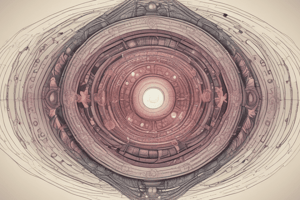Podcast
Questions and Answers
What is invagination in amphibian development?
What is invagination in amphibian development?
- The outward folding of cells.
- The rapid transformation of a simple-structured embryo.
- The fusion of animal cap and vegetal plate cells.
- The inward folding of cells. (correct)
Where does invagination occur in amphibians?
Where does invagination occur in amphibians?
- On the ventral side of the gastrula.
- At the animal cap.
- At the blastopore. (correct)
- Within the archenteron.
What is the role of the blastopore in amphibian development?
What is the role of the blastopore in amphibian development?
- Entryway for migrating cells into the archenteron. (correct)
- Formation of distinct tissues and organs.
- Development of the animal cap and vegetal plate cells.
- Closure of the endoderm cells.
Which germ layers are separated by the blastopore?
Which germ layers are separated by the blastopore?
What is the archenteron in amphibian gastrulation?
What is the archenteron in amphibian gastrulation?
Which process leads to cell movements during gastrulation in amphibians?
Which process leads to cell movements during gastrulation in amphibians?
Which germ layer forms the gut and the respiratory and excretory systems?
Which germ layer forms the gut and the respiratory and excretory systems?
What does involution refer to in amphibian gastrulation?
What does involution refer to in amphibian gastrulation?
What is the circular opening formed on the ventral side of the embryo during development?
What is the circular opening formed on the ventral side of the embryo during development?
Which cell movement involves the spreading of ectoderm over the embryo's surface?
Which cell movement involves the spreading of ectoderm over the embryo's surface?
Which germ layer forms the skeleton, muscles, blood, heart, and kidneys in amphibians?
Which germ layer forms the skeleton, muscles, blood, heart, and kidneys in amphibians?
What does delamination involve in cell movements during gastrulation?
What does delamination involve in cell movements during gastrulation?
Study Notes
Gastrulation in Amphibians: Unraveling Embryonic Development
Gastrulation is a pivotal stage in the development of amphibians, during which a simple-structured, single-layered embryo rapidly transforms into a more complex, multilayered organism. This process sets the foundation for the formation of distinct tissues and organs, ultimately resulting in a fully formed amphibian. In this article, we'll delve into the particulars of gastrulation in amphibians, focusing on invagination, blastopore formation, germ layers formation, and cell movements.
Invagination
Invagination, simply put, is the inward folding of cells. In amphibian development, this occurs at the blastopore, a small opening on the dorsal (upper) side of the gastrula. The blastopore forms upon the fusion of two specialized cells, the animal cap and the vegetal plate. As the blastopore closes, the endoderm cells invaginate, forming the archenteron—the future digestive cavity—which will ultimately expand and become the gut.
Blastopore Formation
The blastopore serves as the entryway for cells that migrate into the archenteron cavity and forms the boundary between the ectoderm (outer layer) and the endoderm (inner layer). The blastopore itself is typically U-shaped in amphibians, but its orientation can vary depending on the species. During development, the blastopore undergoes a series of morphological changes, eventually closing to form a circular opening—the mouth—on the ventral (lower) side of the embryo.
Germ Layers Formation
As the blastopore forms, the amphibian embryo develops three primary germ layers: ectoderm, mesoderm, and endoderm. Each germ layer gives rise to specific tissues and organs:
- Ectoderm: The outermost germ layer forms the skin, nervous system, and sensory organs such as the eyes and ears.
- Mesoderm: The middle germ layer generates the skeleton, muscles, blood, and other internal organs such as the heart and kidneys.
- Endoderm: The innermost germ layer forms the gut and the respiratory and excretory systems.
Cell Movements
Gastrulation in amphibians is a choreographed dance of cell movements. Three fundamental cell movements are involved in gastrulation: involution, epiboly, and delamination.
- Involution: This refers to the inward movement of cells, such as the endoderm cells, that migrate into the archenteron to form the gut.
- Epiboly: This process involves the spreading of the ectoderm over the embryo's surface.
- Delamination: In this movement, cells separate from one layer to form another, as in the formation of the mesoderm from the ectoderm.
In summary, gastrulation in amphibians is a complex and highly regulated process that involves invagination, blastopore formation, germ layers formation, and cell movements. Understanding these principles is essential for elucidating the mechanisms underlying amphibian development and, more broadly, the development of all animals.
Studying That Suits You
Use AI to generate personalized quizzes and flashcards to suit your learning preferences.
Description
Test your knowledge on the intricate process of gastrulation in amphibians, focusing on invagination, blastopore formation, germ layers, and cell movements. Explore how a simple embryo evolves into a complex organism with distinct tissues and organs.




